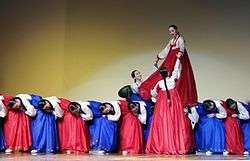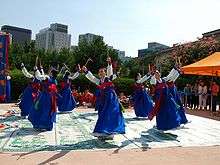Intangible Cultural Property (South Korea)
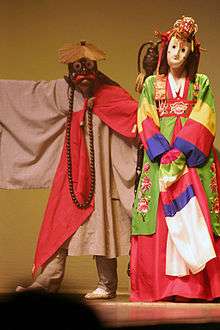
No. 17 Bongsan tal chum (Bongsan mask dance)
The Intangible Cultural Properties (Hangul: 요무형문화재, Muhyeong Munhwajae) are aspects of intangible culture that the government of South Korea has officially designated for preservation in accordance with the 1962 Cultural Property Protection Law.[1][2] They are proclaimed and maintained by South Korea's Cultural Heritage Administration.
Items of particular importance can be designated as Important Intangible Cultural Properties (Hangul: 중요무형문화재, Jungyo Muhyeong Munhwajae).
The first item so designated was Jongmyo jeryeak, the ancient music and dance performed at the Jongmyo Royal Ancestral Shrine in Seoul; it was proclaimed on December 7, 1964. The most recent, announced on November 16, 2006, was Important Intangible Cultural Property 119, geumbakjang (gold leaf decoration), practiced in Seongnam, Gyeonggi-do.
A similarly named yet distinct designation, "Intangible Cultural Properties," also exists, with 33 items having been proclaimed.[3] These are proclaimed by provinces or cities rather than by the national Cultural Heritage Administration.
The 1962 Cultural Property Protection Law was modelled on the Japanese 1950 Law for the Protection of Cultural Properties, which provides for the designation of Intangible Cultural Properties as well as the holders of these craft and performance traditions, known informally as Living National Treasures.[2] These early initiatives at a national level influenced UNESCO in its approach to intangible cultural heritage, leading to the 2003 Convention for the Safeguarding of Intangible Cultural Heritage.[4] As of April 2012, fourteen Korean Intangible Cultural Properties have been inscribed on the UNESCO Representative List of the Intangible Cultural Heritage of Humanity.[5][6]
List
Proclaimed 1960–1969

No. 11
Pungmul, farmers' dance and music

No. 15 Bukcheong sajanoreum
Proclaimed 1970–1979

No. 46 Piri jeongak mit daechwita
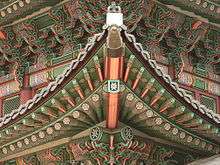
No. 48 Dancheong jang
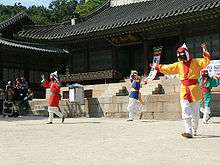
No. 49 Songpa sandaenori

No. 58 Jultagi
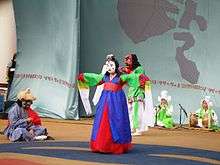
No. 61 Eunyul talchum
| No. |
Title |
Original name |
Description |
Location |
|---|
| 32 |
Gokseongui dolsilnai |
곡성의돌실나이 (谷城의돌실나이) |
Hemp cloth weaving of Gokseong |
The Wide area of Jeollanam-do |
| 33 |
Gossaum nori |
광주칠석고싸움놀이 |
Gossaum game |
The Wide area of Gwangju |
| 34 |
Gangnyeong talchum |
강령탈춤 (康翎탈춤) |
Mask dance drama of Gangnyeong |
The Wide area of Seoul |
| 35 |
Jogak jang |
조각장 (彫刻匠) |
Silver engraving |
The Wide area of Seoul |
| 38 |
Joseon wangjo gungjung eumsik |
조선왕조궁중음식 (朝鮮王朝宮中飮食) |
Royal culinary art of the Joseon Dynasty |
The Wide area of Seoul |
| 39 |
Cheoyongmu |
처용무 (處容舞) |
Cheoyong shaman dance |
The Wide area of Seoul |
| 40 |
Hagyeon hwadae hapseolmu |
학연화대합설무 (鶴蓮花臺合設舞) |
Muhak crane dance |
The Wide area of Seoul |
| 41 |
Gasa |
가사 (歌詞) |
Songs |
The Wide area of Seoul |
| 42 |
Akgijang |
악기장 (樂器匠) |
Traditional musical instrument making |
Nationwide |
| 43 |
Suyeong yaryu |
수영야류 (水營野遊) |
Masked dance drama of Suyeong |
The Wide area of Busan |
| 44 |
Hanjanggun nori |
한장군놀이 (韓將軍놀이) |
General Han's dance and memorial ceremony |
The Wide area of Gyeongsangbuk-do |
| 45 |
Daegeum sanjo |
대금산조 (大금散調) |
solo performance of the daegeum (bamboo transverse flute) |
Nationwide |
| 46 |
Piri jeongak mit Daechwita |
피리정악및대취타 (피리정악및大吹打) |
daechwita royal military march |
The Wide area of Seoul |
| 47 |
Gungsijang |
궁시장 (弓矢匠) |
Korean bow and arrow making |
Nationwide |
| 48 |
Dancheongjang |
단청장 (丹靑匠) |
crafts or craftsman making dancheong, ornamental painting for buildings. |
Nationwide |
| 49 |
Songpa Sandae Noli |
송파산대놀이 (松坡山臺놀이) |
Sandae noli is a mask dance drama of the Songpa region |
The Wide area of Seoul |
| 50 |
Yeongsanjae |
영산재 (靈山齋) |
Yeongsanjae is a Buddhist rite |
The Wide area of Seoul |
| 51 |
Namdo deullorae |
남도들노래 (南道들노래) |
Farmers' songs of Jeolla-do |
The Wide area of Jeollanam-do |
| 53 |
Chaesang jang |
채상장 (彩箱匠) |
Bamboo cases with colored designs |
The Wide area of Jeollanam-do |
| 55 |
Somok jang |
소목장 (小木匠) |
Somok, furniture making |
Nationwide |
| 56 |
Jongmyo jerye |
종묘제례 (宗廟祭禮) |
Jongmyo royal ancestral memorial ceremony |
The Wide area of Seoul |
| 57 |
Gyeonggi minyo |
경기민요 (京畿民謠) |
Folk songs of Gyeonggi-do |
The Wide area of Seoul |
| 58 |
Jultagi |
줄타기 |
Tightrope walking |
The Wide area of Gyeonggi-do |
| 60 |
Jangdo jang |
장도장 (粧刀匠) |
Making small swords |
The Wide area of Jeollanam-do |
| 61 |
Eunyul talchum |
은율탈춤 (殷栗탈춤) |
Masked dance drama of originally Eunyul region, Hwanghae Province |
The Wide area of Incheon |
| 62 |
Jwasuyeong eobang nori |
좌수영어방놀이 (左水營漁坊놀이) |
Jwasuyeong fishing village rite and festival for big catch |
The Wide area of Busan |
Proclaimed 1980–1989

No. 69 Hahoe byeolsingut talnori
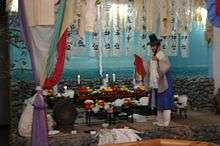
No. 71 Jeju chilmeoridang gut
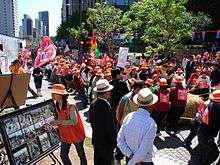
No. 75 Gijisi juldarigi

No. 86 Hyangtosul damgeugi, making local liquor
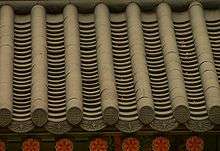
No. 91 Jewajang, making earthenware roof tiles
| No. |
Title |
Original name |
Description |
Location |
|---|
| 64 |
Duseok jang |
두석장(豆錫匠) |
Metal craftsman |
Nationwide |
| 65 |
Baekdong yeonjuk jang |
백동연죽장(白銅煙竹匠) |
Nickel smoking-pipe making |
The Wide area of Jeollabuk-do |
| 66 |
Manggeonjang |
망건장(網巾匠) |
Making manggeon headband |
The Wide area of Jeju-do |
| 67 |
Tanggeonjang |
탕건장(宕巾匠) |
Making Tanggeon hat |
The Wide area of Jeju-do |
| 68 |
Miryang baekjung nori |
밀양백중놀이(密陽百中놀이) |
Baekjungnori of Miryang |
Miryang-si, Gyeongsangnam-do |
| 69 |
Hahoe byeolsingut talnori |
하회별신굿탈놀이(河回別神굿탈놀이) |
Byeolsin, masked dance drama of Hahoe |
The Wide area of Gyeongsangbuk-do |
| 70 |
Yangju sonorigut |
양주소놀이굿 |
Cow play with shaman exorcism of Yangju |
The Wide area of Gyeonggi-do |
| 71 |
Jeju chilmeoridang gut |
제주칠머리당굿(濟州칠머리당굿) |
Jeju-do island Chilmeoridang shrine shaman exorcism |
The Wide area of Jeju-do |
| 72 |
Jindo ssitgimgut |
진도씻김굿(珍島씻김굿) |
Jindo island Ssitgimgut shaman exorcism |
The Wide area of Jeollanam-do |
| 73 |
Gasan ogwangdae |
가산오광대(駕山五廣大) |
Five masked performers' dance drama of the Gasan region |
The Wide area of Gyeongsangnam-do |
| 74 |
Daemokjang |
대목장(大木匠) |
Traditional wooden architecture |
Nationwide |
| 75 |
Gijisi juldarigi |
기지시줄다리기 (機池市줄다리기) |
Juldarigi means tug-of-war in native Korean, and the nori (game) originated in the Gijisi region, Dangjin, Chungcheongnam-do |
The Wide area of Chungcheongnam-do |
| 76 |
Taekkyeon |
택견 |
Taekkyeon martial art |
The Wide area of Chungcheongbuk-do |
| 77 |
Yugijang |
유기장(鍮器匠) |
brassware artisans |
Nationwide |
| 78 |
Ipsajang |
입사장(入絲匠) |
Silver wire inlaying |
The Wide area of Seoul |
| 79 |
Baltal |
발탈 |
Puppet placed on and manipulated by the foot |
Nationwide |
| 80 |
Jasujang |
자수장(刺繡匠) |
Embroidery |
Nationwide |
| 81 |
Jindo dasiraegi |
진도다시래기(珍島다시래기) |
Dasiraegi play of Jindo island |
The Wide area of Jeollanam-do |
| 82 |
Pungeoje |
풍어제(豊漁祭) |
Rite and festivals for big catch of fish |
Nationwide |
| 82-1 |
Donghaean byeolsin gut |
동해안별신굿 |
Byeolsingut of the eastern coast |
The Wide area of [[Busan |
| 82-2 |
Seohaean baeyeonsin gut mitdaedong gut |
서해안배연신굿 및 대동굿 |
Baeyeonsingut and daedonggut of the western coast |
The Wide area of Incheon |
| 82-3 |
Widottibaen nori |
위도띠뱃놀이 |
Ttibaennori of Wido island |
The Wide area of Jeollabuk-do |
| 82-4 |
Namhaean byeolsin gut |
남해안별신굿 |
Byeolsingut of the southern coast |
The Wide area of Gyeongsangnam-do |
| 83 |
Hyangjejul pungnyu |
향제줄풍류(鄕制줄風流) |
Hyangjejul local music |
Nationwide |
| 83-1 |
Guryehyangjejulpungnyu |
구례향제줄풍류 |
Hyangjejul local music of Gurye |
The Wide area of Jeollanam-do |
| 83-2 |
Irihyangjejulpungnyu |
이리향제줄풍류 |
Hyangjejul local music of Iri |
The Wide area of Jeollabuk-do |
| 84 |
Nongyo |
농요(農謠) |
Farmers' songs |
Nationwide |
| 84-1 |
Goseong nongyo |
고성농요 |
Farmers' songs of Goseong |
The Wide area of Gyeongsangnam-do |
| 84-2 |
Yecheon Tongmyeong Nongyo |
예천통명농요 |
Farmers' songs of Tongmyeong in Yecheon city |
The Wide area of Gyeongsangbuk-do |
| 85 |
Seokjeondaeje |
석전대제(釋奠大祭) |
Ceremony in honor of Confucius |
The Wide area of Seoul |
| 86 |
Hyangtosul damgeugi |
향토술담그기 |
Making local liquor |
Nationwide |
| 86-1 |
Munbaeju |
문배주 |
Distilled liquor |
The Wide area of Seoul |
| 86-2 |
Myeoncheondugyeonju |
면천두견주 |
Azalea petal wine of Myeoncheon |
The Wide area of Chungcheongnam-do |
| 86-3 |
Gyeongju Gyodong Beopju |
경주교동법주 |
Glutinous rice wine of Gyo-dong in Gyeongju |
The Wide area of Gyeongsangbuk-do |
| 87 |
Myeongju jjagi |
명주짜기 |
Making silk |
The Wide area of Gyeongsangbuk-do |
| 88 |
Badijang |
바디장 |
Making reed |
The Wide area of Chungcheongnam-do |
| 89 |
Chimseonjang |
침선장(針線匠) |
Sewing traditional clothing |
The Wide area of Seoul |
| 90 |
Hwanghaedo Pyeongsan sonoreum gut |
황해도평산소놀음굿(黃海道平山소놀음굿) |
Pyeongsan sonoreumgut shaman rite of Hwanghae-do |
The Wide area of Incheon |
| 91 |
Jewajang |
제와장(製瓦匠) |
Making earthenware roof tiles |
The Wide area of Jeollanam-do |
| 92 |
Taepyeongmu |
태평무(太平舞) |
Dance of Peace |
The Wide area of Seoul |
| 93 |
Jeontong jang |
전통장(箭筒匠) |
Quiver making |
The Wide area of Gyeongsangbuk-do |
| 95 |
Jeju minyo |
제주민요(濟州民謠) |
Folk songs of Jeju island, including "Odolttogi," "Sancheonchomok," "Bongjiga," and "Maettolnorae," |
The Wide area of Jeju-do |
Proclaimed 1990–1999
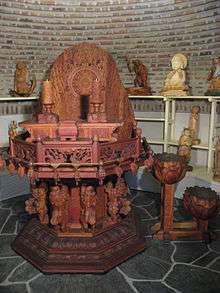
No. 108 Mokjogak jang
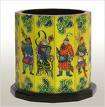
| No. |
Title |
Original name |
Description |
Location |
|---|
| 96 |
Onggijang |
옹기장(甕器匠) |
Making onggi, earthenware pottery |
The Wide area of Jeollanam-do |
| 97 |
Salpurichum |
살풀이춤 |
Solo dance for spiritual cleansing |
The Wide area of Seoul |
| 98 |
Gyeonggi-do dodang gut |
경기도도당굿(京畿道都堂굿) |
Tutelary Rite of Gyeonggi-do]] |
The Wide area of Gyeonggi-do |
| 99 |
Sobanjang |
소반장(小盤匠) |
Tray-table carpentry |
The Wide area of Seoul |
| 100 |
Okjang |
옥장(玉匠) |
Jade craftsmanship |
The Wide area of Jeollanam-do |
| 101 |
Geumsokhwalja jang |
금속활자장 |
Art of movable metal type |
The Wide area of Chungcheongbuk-do |
| 102 |
Baecheopjang |
배첩장 |
Mounting |
The Wide area of Seoul |
| 103 |
Wanchojang |
완초장 |
Sedge work (making mats, cushions, mattresses, bowls, and baskets from sedge plants) |
The Wide area of Incheon |
| 104 |
Seoul Saenam gut |
서울새남굿 |
Shaman rite of Seoul for guiding a departed spirit into the land of bliss |
The Wide area of Seoul |
| 105 |
Sagijang |
사기장 |
Art of ceramics |
The Wide area of Gyeongsangbuk-do |
| 106 |
Gakjajang |
각자장 |
Calligraphic engraving |
The Wide area of Seoul |
| 107 |
Nubijang |
누비장 |
Quilting |
The Wide area of Gyeongsangnam-do |
| 108 |
Mokjogakjang |
목조각장 |
Wood sculpture |
The Wide area of Gyeonggi-do |
| 109 |
Hwagakjang |
화각장 |
Ox horn inlaying |
The Wide area of Incheon |
| 110 |
Yundojang |
윤도장 |
Making geomantic compasses |
The Wide area of Jeollabuk-do |
Proclaimed 2000-2009
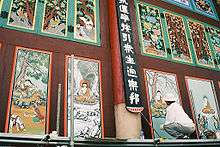
No. 118 Buddhist painting and painter
| No. |
Title |
Original name |
Description |
Location |
|---|
| 111 |
Sajik daeje |
사직대제 |
Ceremony for ancestors |
The Wide area of Seoul |
| 112 |
Jucheoljang |
주철장 |
Cast iron |
Seocho-gu, Seoul |
| 113 |
Chiljang |
칠장 |
Lacquer work |
Dobong-gu, Seoul |
| 114 |
Yeomjang |
염장 |
Bamboo blind making |
Tongyeong-si, Gyeongsangnam-do]] |
| 115 |
Yeomsaekjang |
염색장 |
Dyeing |
Naju, Jeollanam-do |
| 116 |
Hwahyejang |
화혜장 |
Making traditional Korean shoes |
Songpa-gu, Seoul |
| 117 |
Hanjijang |
한지장 |
Making traditional Korean paper |
The Wide area of Gyeonggi-do |
| 118 |
Bulhwajang |
불화장 |
Buddhist painting, designated on January 10, 2006 |
Nationwide |
| 119 |
Geumbakjang |
금박장 |
Gold leaf decoration for hanbok, designated on November 16, 2006 |
Seongnam, Gyeonggi-do |
| 121 |
Beonwajang |
번와장 (翻瓦匠) |
roof tiles , designated on October 21, 2008[7] |
|
See also
References
External links
|
|---|
| National level | |
|---|
| International | |
|---|


